Why should you run an indoor marathon and what you can learn from it?
The way to results is to be resistant to boring.
When you grind to get results, you will hit patches where you have to do the same thing over and over again.
Doing boring things will build your tolerance to power through.
Some time ago, I followed a pretty boring treadmill training routine. So, I jumped at an opportunity to add some variety to the treadmill runs. I signed up for the Tondiraba Indoor Marathon. I had no plans to get any personal bests. My goal was to get an interesting experience and increase my ability to withstand boring.

Indoor marathon track and setup

Hydration during the indoor marathon is peculiar because there was one aid station. So, you could drink or eat something on every lap of 252 meters. This created some mental load, when should I drink, when should I eat.
Make a plan how much and how often you want to eat or drink.
Tracking time during the indoor marathon
I have set up my phone with Endomondo to keep track of my running. The main feature for me is that I have set it up to tell me the distance, pace, and heart rate after every 500 meters. Obviously, this doesn’t work indoors. Sadly, Endomondo informed me, “GPS signal lost.”
The most important thing I want to monitor is my heart rate. I changed the audio coach from the distance setting to duration, and now it gave me my heart rate every 2 minutes.
For the distance and pace, I used the huge TV screen on the start-finish line. Checking your time on the screen was a little unfamiliar experience but no big deal. The inconvenience of checking the time on the screen became more apparent in the last 10 kilometers.
Favorite songs
The indoor marathon made it possible to play their favorite songs for the runners. During the registration, you could send the names of two songs to the organizers. I’m a metalhead but figured that I wouldn’t torture other runners by sending in Slayer’s Angel of Death.
My first song was about running. Iron Maiden, The Loneliness of the Long-Distance Runner.
And the second song was one of my all-time favorites, Metallica’s Master of Puppets.
This song is over 8 minutes long, and the DJ got tired of it even before the quiet part in the middle. I thought to myself, what would have happened if I had sent in Vivaldi’s Seasons that’s more than 40 minutes long?
One problem with the songs and the whole sound system was that you could hear the speakers only on one part of the track. For me, that segment was approximately 25 seconds long. But it’s still cool when they play your song.
My two songs came at the very beginning of the run, and after that, I put my music on my headphones. My soundtrack is always great as it plays my favorites in random order. Totally randomly, that included Vivaldi’s Seasons.
Distance and running a curve
Math problem: Earth’s path around the sun is approximately 942 kilometers. If you move our planet’s orbit one meter farther from the sun, how much longer will the orbit become?
Now solve it!
I’ll wait…..
Of course, unlike you, most people will not solve it and just guess.
The numbers they guess are usually in millions of kilometers. The reason is probably that they were out running during that class.
But here’s the solution
The length of earth’s orbit is: 2 x Pi x Radius = 2 x 3.14 x 150,000,000 km = 942 million kilometers.
When we add 1 meter to the radius, then we get the following calculation:
Then length of earth’s orbit is: 2 x Pi x (Radius +1m) = 2 x 3.14 x 150,000,000km + 2 x 3.14 x 1m = 942,000,000km + 6.28m.
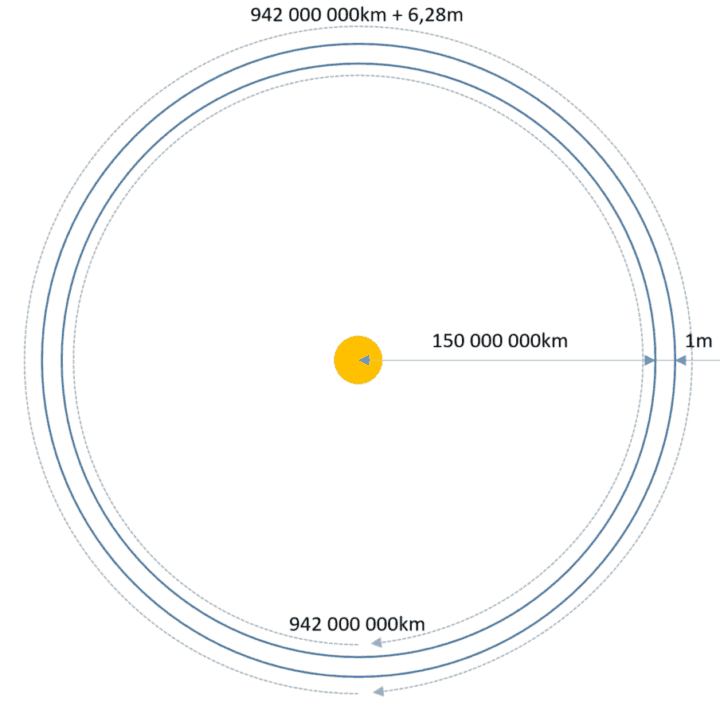
As you can see, the one-meter increase in radius adds only 6.28 meters to the length of the orbit. The result is always the same, no matter how big the original circle.
So, what this has to do with running?
The indoor marathon track is a circle. Every meter you are farther from the inner edge of the track adds 6.28 meters to the lap. Usually, it doesn’t matter that much, but if you run 167 laps, then there’s a huge difference.
If you run 1 meter from the edge, then you make your run a lot longer. 6.28 meters more for 167 laps means 1049 meters longer.
I attended that math class and tried to run as close to the inner edge of the track as possible. The whole running area was about 4 to 5 meters wide, and some people ran in the middle of it.
Not listening in the math class led them to run a marathon plus 2 kilometers.
Running close to the edge came at a cost. I ran into the wall once and bruised my elbow . Usually, you don’t have that when running a marathon.
Hitting the wall got a completely new meaning for me in that race.
Another aspect of the indoor marathon on a short lap is that I don’t really know how much I ran. If the organizers measured the length of the lap from the middle of the running area, then I ran 2 kilometers less than a marathon.
Running faster by cutting corners
Cut every corner!
Although the curve radius idea occurred to me where it most mattered, it’s important in every race that is not a straight line.
Add up all the turns you have to make. Left or right, it doesn’t matter. As most races start and finish in the same location, you will get at least 360 degrees of curves. In winding city marathons, you could win hundreds of meters by running as close to the corner as possible.
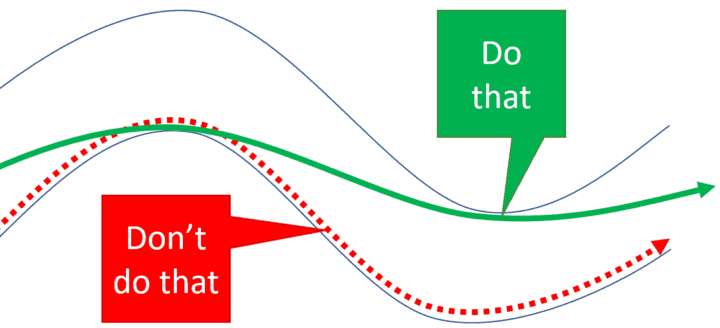
The rule for cutting corners says that you can cut everything that’s not blocked by tape, barricades, cones, or other signs.
Take advantage of that.
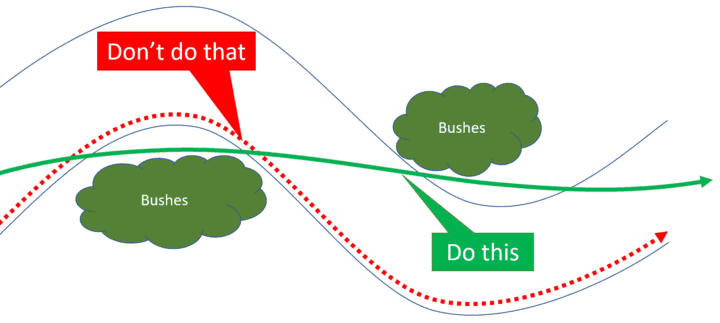
Let’s assume there’s a regular 2-way street on the picture above. The green runner gets a 5 to 10-meter advantage on that single bendy part of the track. Usually, there are dozens of bends in a marathon.
Every time you don’t run the corners right through the apex, you are making yourself run a longer distance. It’s amazing to watch how people run on one side of the street when they have the whole width of the street for running.
Don’t do that!
Cutting corners is especially important when running ultras. Ultramarathons are often run on bendy roads or short loops, where running corners in the right way will give you a tremendous advantage.
Other runners, fast and slow
A special feature of the indoor marathon is that no matter how fast you are, you pass other runners all the time. And then there are those who run past you, dozens of times.
I tried to avoid slowing down the faster runners and pass the slower ones as smoothly as possible. It’s probably quite demanding mentally for the fastest runners and makes it harder to follow the optimal path.
My first indoor marathon in numbers
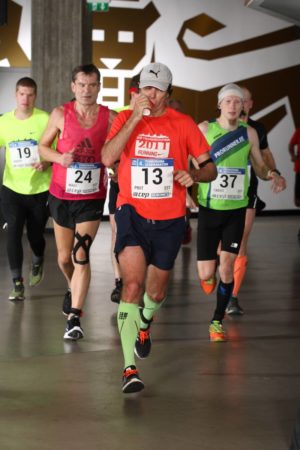
- No wind,
- no bugs,
- smooth surface,
- aid station every 252 meters,
- comfortable temperature, and
- zero ascent.
The favorable conditions are probably the reason that I got almost 10 minutes better result than I expected.
The indoor conditions are also perfect if you want to run with Huarache running sandals or even barefoot.
My running pace was very stable. When I exclude the laps where I drank or ate and the one where I literally hit the wall, then my lap times where between 1:11 and 1:13. These times translate to kilometer pace in the range of 4:40 to 4:50. That’s from 7:30 to 7:47 per mile.
My heart rate was also very stable. Below 160 in the first half of the marathon. Then it started to pick up. From 21k to 32k, my heart rate was around 165. Finally, in the last 10 kilometers, my heart rate went above 170 beats per minute.
Before that race, I experimented with the idea to bring the heart rate down through deep and calm breathing. The breathing technique helped me bring the heart rate below 170 at the very end of the race. Usually, my heart rate goes above 180 in the last kilometers. In this event, I had a lot of beats left. And this allowed me to go for an all-out sprint on the last lap.
Always finish strong!
In a marathon, everybody can start strong, but I try to pick up the pace at the end. After completing the 166th lap, I raised my pace as high as I could. I could have run that lap even faster, but I had to avoid hitting other runners. I was the fastest runner on that lap (the winners had already finished).
I ran the last 252-meter lap in 52 seconds, and that means 3m27s kilometer pace (5:33 minutes per mile). I was surprised that the last lap didn’t take all out of me, and I could have run another one.
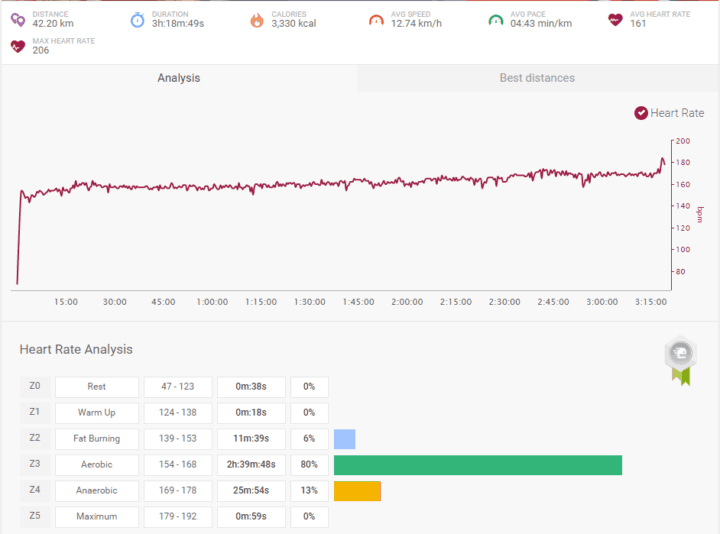
The result 11th place with 3h18m49s; there weren’t too many runners to begin with.
At some point, I had an idea to run another 7.8 kilometers so I could have a new 50k personal best. That thought dissolved around 39 kilometers when I started to feel the marathon in my body.
Preparation for the indoor marathon
For 6 weeks before the indoor marathon, I had my special training routine. I simply run very slowly, keeping the heart rate below 140 beats per minute.
Then every week, I add a bit of speed. Usually, 0.1kmph. So that the heart rate wouldn’t go above 140. The indoor marathon was kind of test if the idea works or not. It seems that it does work. I’ll keep doing that.
I have been trying to lose weight int the last month. I am about 6 pounds above my ideal running weight.
I didn’t have any other preparation or training. I didn’t load any carbs as this was an experiment. My work schedule didn’t allow me to have a good training calendar before the event. My last run before the marathon was 8.5 kilometers 5 days before the event.
The night before the event, I ate a bit more carbs than usual. I ate a pizza and some fruit but didn’t really LOAD carbs.
I slept for seven and a half hours. On the morning of the event, I didn’t eat anything. I drank one large cup of coffee with butter to kick-start my metabolism so I wouldn’t need to use the restroom during the race.
Considering all that non-preparation, I would say that I was in better shape than my marathon time suggests. If I had done all this and that, should have, could have, then I could have maybe got to 3 hours and 14 minutes. However, the slower pace left plenty of room to enjoy the run, and I also felt fine shortly after the run.
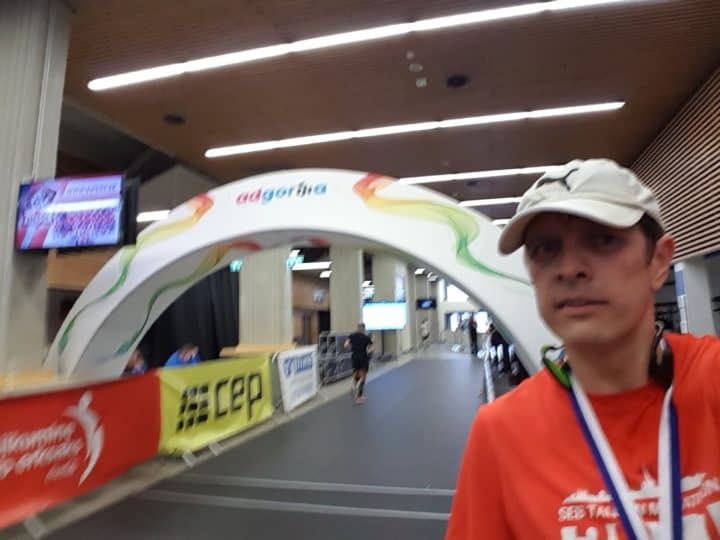
Recovery
As usual, I didn’t read the instructions or the race website. Because of that, I didn’t know that there was a sauna. I didn’t have a towel. But I had the shirt that worked as well. I went to the sauna, drank a huge amount of water, Coca-Cola, and kefir. And then four hours after the start left the building.
As expected, my legs were just fine on the following days. I had some tightness in the thigh and calf of the left leg. The left leg was the inner leg when running laps and maybe had to bear slightly more weight. Next time I should run half of the distance in one direction and then turn around for the second part.
All things considered, this was one of the best marathons that I have ever run. I intend to do it again and find other indoor marathons to try. If you have an indoor marathon, you can attend, go!
2020 update
I loved my first indoor marathon so much I went back. This time it was much harder for me. My time was 3:30. I started at the same pace as last time, but in the second half of the run, the pace dropped more than a minute per mile, and the effort was much greater.
Here’s the graph of how my running speed changed during the race. The small dips are visits to the aid stations for drinking. The dip in the 134th lap happened because the race leader collapsed some 60 meters before the finish in cramps. I stopped to see him cross the finish line with the new Estonian indoor marathon record.
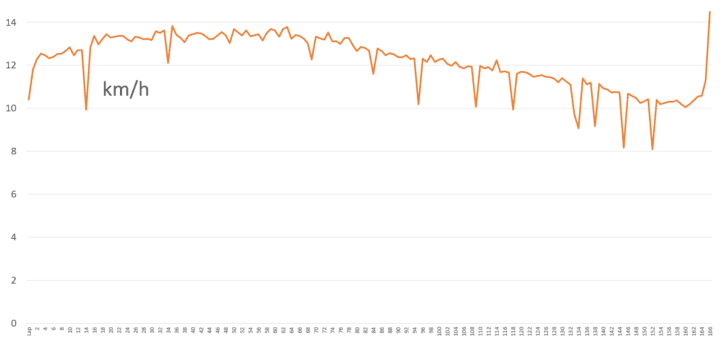
The slight increase in the last few laps and the peak on the last lap happened because I always try to finish strong. Anyone can start strong, but always put in the extra effort and go all out. Even if for a few hundred meters.
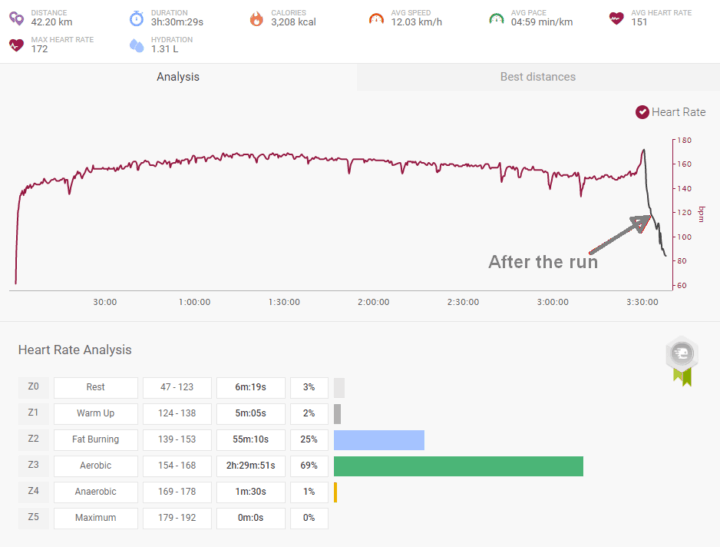
In 2020 my time for the last lap was 63 seconds, 11 seconds more than in 2018, and I couldn’t have run any faster.
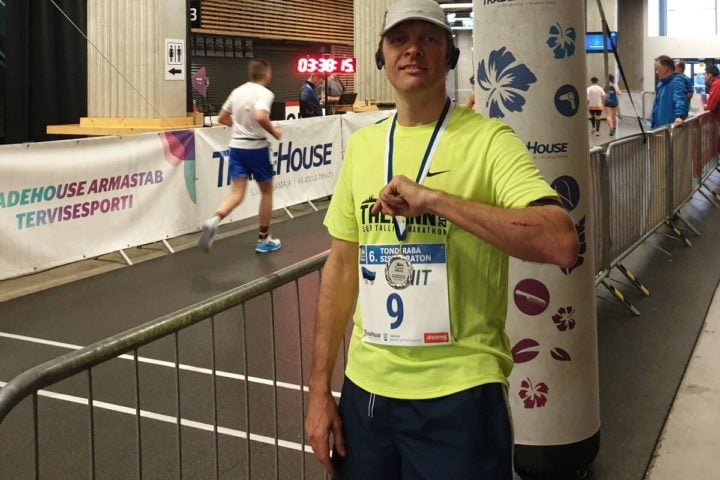
As usual, I ran into the wall again, and now, I have some scratches to show for it.
Read about how I ran my first 100k+ ultra.

![Read more about the article What You Can Learn from My First Ultra-Marathon [72K/45M]](https://fixwillpower.com/wp-content/uploads/first-ultra-marathon-selfie-learn-429x314.jpg)

What I loved most about running a marathon indoors was that it’s absolutely flat and doesn’t any wind.